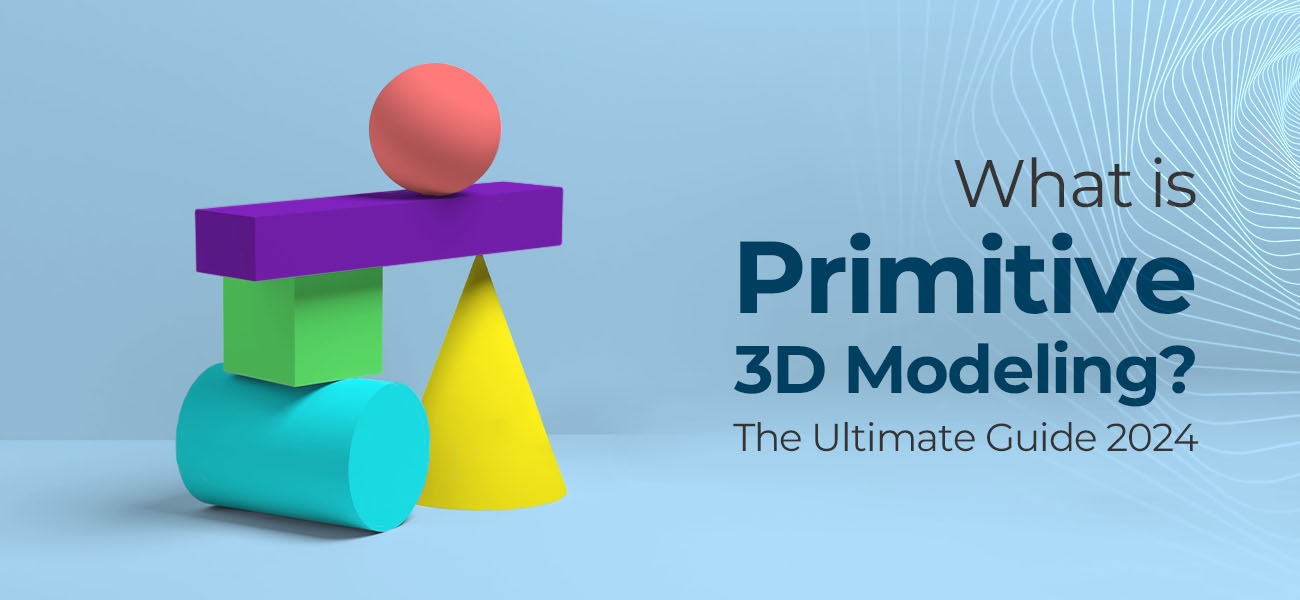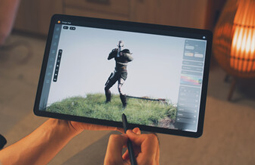What is Primitive 3D Modeling?
3D primitives are the most rudimentary components of 3D model creation and are the most undemanding on any computer system. That’s the reason primitive 3D modeling is quite an important part of the CAD process for creating simple 3D geometries. With primitive modeling, professional 3D modelers create compound shapes that act as the foundation for detailed 3D designs with more added details.
This article will try to breakdown all the facets of primitive model design, its significance and applications, types, benefits, and challenges. Also, as a bonus, readers will get to know the best ways of developing primitive shapes.

What is primitive 3D modeling?
Primitive modeling is a very elementary 3D design process that utilizes simple geometric shapes like spheres, cylinders, cubes, tori, etc. These simple shapes are then developed into complex and detailed 3D models with minimal effort. The simplicity of this modeling process is what makes it widely used in a number of industries like architecture, video game development, healthcare, automotive, etc.
Creating complicated geometric 3D objects with primitive building blocks is mostly done to check the final layout of a construction, mechanical designs, or even organic designs. The time taken is way less than conceptual solid, surface, or polygonal modeling.
An example of primitive 3D modeling is that modelers can turn a cylindrical shape into a flat tree trunk and then sculpt it further to give it a life-like, organic structure. Other modified components, like a sphere, box, or cube, can be added for further detailing.
Significance of 3D primitive modeling technique in 3D modeling
Although not as hyped as the other common techniques like wireframe, solid, or surface modeling, primitive modeling does have several benefits for modern 3D design. The process facilitates spatial visualization and offers creative flexibility that helps designers drive innovation.
Following are the overarching benefits of primitive modeling:
-
Rapid prototyping and design iteration
Primitive 3D design offers a high level of versatility and simplicity that helps expedite the prototype or model creation process. Modelers can quickly manipulate primitive shapes and create rough drafts of the models, i.e., facilitate a fast iteration workflow. Thus, primitive modeling techniques lead to faster development and design iteration.
Scope for experiment
Primitive 3D modelers get ample scope to experiment with different proportions, forms, and compositions while refining the models further. They can start with simple geometric forms and then add further intricate details and fine-tune the models.
-
Integration with other advanced modeling techniques
Primitive modeling techniques seamlessly integrate with other advanced modeling techniques. This helps the designers achieve realism and detailing by pushing the boundaries. For instance, simple shapes like cubes, spheres, boxes, and cylinders can be augmented with texturing, sculpting, lighting, and shading.
-
Primitive technique is highly adaptable
With this digital modeling technique, 3D designers can custom-create the shapes to suit the ultimate project requirements. They can tailor the shapes by manipulating parameters like rotation, size, height, depth, width, subdivision levels, etc., to achieve the desired forms.
-
Helps in spatial visualization and planning
3D geometric primitives provide a tangible representation of objects in 3D space. This is leveraged by modelers for spatial visualization and planning. For instance, spatial layouts of the interior/exterior help architects ideate the spaces in and out of an architectural structure.
Mechanical product designers gain significant insights into the proportion and scale of an actual physical component. This has a big contribution towards identifying potential design flaws and optimizing spatial arrangements.
-
Efficient designing workflow
The best part of primitive geometrical modeling is that it is a very simple modeling process that requires the least amount of effort and resources. This is further made possible by premade or pre-built primitive shape templates that designers can utilize. Professional 3D services providers leverage these templates to enhance their workflow efficiency and generate repetitive elements.
Different types of 3D primitives
There are quite a few variations of primitive models, each having its own distinct parameters. These different types of primitive 3D models are used in tandem by professional 3D modelers and designers to achieve the desired configuration.
The most common types are as follows:
- ✔ Cube
- ✔ Plane
- ✔ Wedge
- ✔ Pyramid
- ✔ Cylinder
- ✔ Sphere
- ✔ Cone
- ✔ Tori
- ✔ Box
- ✔ Dome
- These are the most common examples of solid primitive shapes utilized to create complex digital models through dynamic procedural generation. Designers assign distinct resolution levels to each of these shapes to adjust and manipulate the number of shapes and sides defining them.
Applications of primitive models across diverse industries
The usage of primitive shapes is mostly reserved for some of the mainstream industries, where they are considered the foundational blocks. Professional production designers add a lot of variety by combining these simple 3D representations for more complex simulations and models.
Check out the diverse industries and sectors that reap benefits by applying primitive modeling techniques within their operations.
-
Automotive industry
Automotive engineers leverage advanced modeling software and tools to implement primitive 3D models in the design and prototyping of vehicle components. Components such as vehicle chassis, body panels, and engine blocks - can all be represented by the basic geometric shapes for further refining and assessment.
-
Manufacturing industry
Heavy goods manufacturing enterprises employ primitive models for various purposes. Especially for assembly processes, conducting machine testing, and streamlining production workflows. 3D models made with this technique appear simple yet defined by parameters. Hence, they help the designers identify potential design flaws quickly and facilitate rapid prototyping.
-
AEC (architecture, engineering, and construction) industry
Modern architects utilize primitive digital models for initial concept visualization and spatial planning. Shapes like cylinders, spheres, tori, domes, etc. are used to develop rough drafts of potential constructions. These rough drafts or plans are generally shown to stakeholders and clients for discussion before finalizing the detailed designs. The primitive models serve as the foundation for further intricate architectural visualizations.
In architectural design, primitive 3D objects are used for initial concept visualization and spatial planning. Architects leverage primitive shapes like cubes, cylinders, and pyramids to create rough drafts of buildings, facilitating discussions with clients and stakeholders. The models are also used to assess scale and understand spatial relationships, enhancing the efficacy of the proposed designs.
-
Video game development and media entertainment industry
The video game development and entertainment industries widely utilize primitive 3D shapes as placeholders during the initial development phases. Basic geometric shapes help game character designers develop characters, create 3D digital graphics, lay out levels, prototype game mechanics, etc. These are crucial stages in the game development lifecycle before investing in high-end resources.
The models are also deployed in virtual environments experiences allowing designers to test user interactions. Furthermore, gamers also relish the AR/VR-driven game environments.
-
Healthcare industry
In the healthcare and medical domains, primitive 3D models facilitate surgical training, medical education, diagnoses and assessments, patient care, testing of different treatment techniques, and more. Surgeons utilize simple 3D organ models to practice surgical procedures, simulate operation theatres, hone their surgical skills, and prevent risk during real surgeries.
Medical students use interactive anatomy models built with primitive modeling to understand complex human anatomy, bone structures, and pathological conditions.
-
Education industry
In modern educational settings, simple primitive models are utilized in virtual laboratories to visualize scientific principles and theories, and so on. They are considered valuable tools to illustrate complex mathematical concepts, provide simulations, and foster engagement among students. The best part is that this approach to disseminating training and education caters to diverse learning styles.
Pros and cons of using 3D primitive shapes
Simple and basic geometric shapes have both advantages and disadvantages in the modeling process. This segment of our insightful article explores the pros and cons of using primitive shapes, with a focus on their utility and potential drawbacks.
Pros
- Simple to create and manipulate, ideal for beginners and professionals alike.
- Allows for rapid prototyping and design alterations without intricate detailing.
- Easy learning curves make the skill development process easier.
- 3D designers and engineers can swiftly assemble and arrange basic geometric forms to construct complex objects or scenes.Undemanding on computers; require hardware with low to medium configuration.
- Speedy workflows due to less complex modeling process. This is beneficial in industries where tight deadlines and frequent design changes are common.
- High degree of creative flexibility; allows modelers to transform and combine the shapes to create a wide range of objects.
- Fewer polygons ensure more optimized models, making them ideal for real-time rendering, rigging, and animation.
Cons
- Lack of detail and realism present in real-world objects. This limits their ability to replicate natural features and textures.
- Not ideal for hyper-realistic renders and simulations.
- Require additional detailing techniques like sculpting, texturing, etc. to enhance visual realism.
- It is challenging to represent organic landscapes and detailed human anatomy using primitive 3D shapes alone.
- Lack of visual interest and diversity due to fixed and identical geometric shapes and patterns.
- Assembling several primitive 3D blocks often leads to a cluttered modeling environment.
So you see, if primitive shapes are utilized judiciously with additional tools and plug-ins, modelers can achieve substantial efficiency and high-fidelity in their workflows. That is why, it is best to hire professional 3D modeling services providing companies. These external companies have experts who are fluent in other advanced modeling techniques as well as using cutting-edge technologies.
Final words
There you are! A compact, insightful, and detailed account of the primitive 3D modeling technique that has recently gained significant traction across most business sectors. Hope you have learned quite a few things about the modeling technique and how it is contemporary in modern engineering designs and simulations. From architecture to automotive, primitive models are pivotal foundational blocks.
As technology evolves, we might get to see many more applications of the technique, creating much more detailed prototypes and enhanced visualization. To harness the true potential of 3D primitives, collaborate with an expert agency offering top-notch 3D design services.




